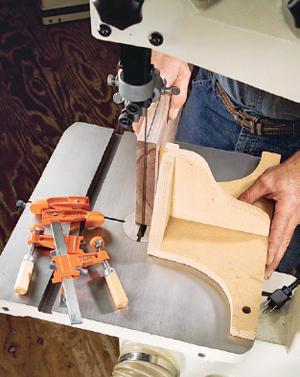
I have a couple of questions concerning resawing. I typically use oak, cherry and hard maple. The questions are as follows:
A) To compensate for blade drift, I will use an oak piece to identify the drift angle. Then I set my fence to the angle. Do I have to set the drift angle for each species of wood that I use?
B) In various wood magazines, yours included, I see that one person sets the piece that is resawn furthest away from the fence. In other articles, I see that the resawn piece is next to the fence. Which is the correct and proper method, or is there really a correct and proper method? – Gus Gonos
Chris Marshall: Blade drift has more to do with the manufacturing idiosyncrasies of the blade you are using and your band saw than it does the species of wood you are trying to cut. You may have to reset the fence for blade drift as the blade wears and dulls or to compensate for where it happens to be positioned on the machine’s flywheels, but once it’s dialed in, the blade should cut oak, cherry and hard maple equally well.
When I resaw, I use a “point fence” and set it so the fall-off piece is on the outside of the blade, furthest from the fence. That’s just habit, and if I’m resawing lumber to simply split it in two, the fall-off piece is no different than the piece adjacent to the fence. If I were going to cut lots of veneer to the same thickness, I’d opt to have the veneer situated between the blade and fence; one blade/fence setup would keep every piece of veneer consistently thick. But, the thinner the veneer, the closer the blade gets to the fence. I wouldn’t want any blade deflection to accidentally cut my fence. Use your best judgement. If you’ve got a resawing setup that works well for you, keep using it! If it’s safe and works effectively, that’s “right” enough.
Rob Johnstone: Like Chris, I am a big fan of the point fence technique for resawing. It allows on-the-fly adjustment to blade drift. The point fence is particularly good for smaller and lower powered band saws — like the 14” saws that most of us have in our shops. A couple other tips may be helpful. Use the widest blade that your band saw can handle: in resawing, the wider the blade, the straighter it wants to cut. Sharper is always better, too. Also, make sure you have proper tension on the blade (maybe even just a bit more tension than recommended).





